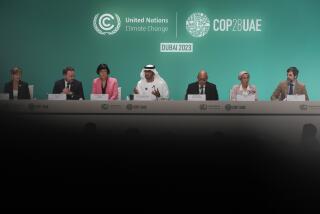In global climate talks, some major polluters drag their feet
Reporting from Washington — Recent commitments by the world’s major polluters to cut emissions have added fresh momentum to international climate talks, but foot-dragging persists among the next tier of polluters, including India, Brazil, Canada and Australia.
Representatives of nearly 200 countries are meeting in Peru, and by the weekend, they must produce building blocks for a global accord to cut heat-trapping emissions and help poorer nations cope with damage from an already-hotter planet. The final agreement is supposed to be signed in Paris a year from now.
Two decades of international talks have done little to rein in growing emissions, but the two top emitters, China and the United States, made a joint announcement last month of ambitious plans to address their pollutants. The European Union also pledged deep cuts.
But in some countries, including developing nations such as India and Brazil and less populous but developed nations such as Canada and Australia, domestic political and economic exigencies have made leaders reluctant to take bold steps to battle climate change. Unless some of them shift their stance over the next few days and through the next year of talks, an agreement that produces meaningful emissions reductions could prove elusive.
When “countries don’t come in as ambitiously as they should, momentum is one fallout,” Dale Marshall, of the Canadian group Environmental Defence, said from Lima, Peru. “We have one year left before Paris and that’s not much in terms of climate talks, and it helps when you have countries that push them forward.
“There’s also a substantive fallout. There are a number of issues that have to be addressed so that Paris will have all the elements of a deal ready to go.”
The U.S.-China climate deal raised hope that India, the world’s third-largest emitter of greenhouse gases, would commit to reducing its emissions of carbon dioxide, the most prevalent greenhouse gas.
But Prime Minister Narendra Modi, who swept into power in May largely on promises to revitalize India’s slowing economic growth, has emphasized industrial development over environmental protection.
India is in the midst of a major economic expansion driven mainly by burning coal, which provides more than 60% of the country’s electricity. Major new coal plants are coming online rapidly as India tries to bring power to the 400 million people — one-third of its population — who lack it and the hundreds of millions more who have only spotty access.
Indian officials have signaled that their emissions will rise and they won’t be forced into making cuts that they contend would hamper economic growth. Last week, before arriving in Lima, Indian Environment Minister Prakash Javadekar said: “Poverty needs to be eradicated immediately. Poor people have aspirations. We must fulfill them. We must give them energy access.”
Modi has announced plans to boost renewable energy, chiefly solar power, and to modernize India’s inefficient electrical grid, which experts say could reduce emissions from burning coal by 30%. But analysts say India’s vulnerability to climate change — with disastrous flooding and erratic monsoon rains in recent years — gives Modi reason to pursue low-carbon policies.
“It’s inevitable that India has to emit more, but it has to be in a much more controlled, efficient manner,” said Krishnan Pallassana, head of the India office of the Climate Group, a British-based advocacy organization. “If we do that, we will be in a better position not only in terms of climate negotiations but also in showing the way for other developing economies.”
Like India and other developing countries, Brazil took the position that richer nations such as the United States should cut their emissions, given how much they had pumped into the atmosphere, while less developed states should do nothing. But China’s willingness to act also increased pressure on Brazil to step up.
For several years, Brazil’s emissions fell as it reduced deforestation, which involved cutting down vast swaths of the Amazon basin and burning the underbrush to clear the land for agriculture. But its emissions rose again in 2013, as deforestation increased once more.
Brazil, for the time being, is hewing to its historic position that developing countries need to do little to decrease emissions and rich countries should make mandatory cuts, which puts it at odds with the U.S. But if it pushes too hard, Brazil risks becoming the culprit for stalled talks — a label no country wants.
Countries such as India, Brazil and Australia play a key role as a bridge between the biggest polluters and poorer countries such as those in Africa, said Erwin Jackson, deputy chief executive of the Climate Institute, an Australian environmental group.
Poor nations have emitted the least greenhouse gases historically but stand to suffer the most from climate change and can be skeptical of the biggest polluters. Nations in between can serve as conduits between the two sides, but not if they are reluctant to reduce their own emissions.
Australia is among the world’s highest per-capita emitters of greenhouse gases, at four times the global average. Since coming to power 14 months ago, Prime Minister Tony Abbott has oriented the economy toward more coal mining and exports and rolled back efforts to reduce emissions.
Australia plans to cut emissions by 12% below 2005 levels by 2020, an even more modest target than the U.S. goal of 17%. Abbott had refused to donate to an international climate fund that would help developing countries prepare for climate change. As more countries gave money, including a U.S. pledge of $3 billion, Abbott reversed himself this week by offering $200 million — but with strings attached.
Canada has been a reliable ally for Australia over the last year, as it too stepped back from aggressive climate action.
Historically, Canada was ahead of the U.S. in addressing climate change. But the government of Prime Minister Stephen Harper pulled out of the Kyoto Protocol, the landmark accord under which some developed countries agreed to cut emissions drastically.
Canada, like Australia, has hitched its economic future to fossil fuel growth, especially development of unconventional natural gas and oil sands. But the oil and gas sector has fast become the single biggest emitter in Canada, and despite numerous pledges, the Harper government has not proposed rules to curtail its greenhouse gases.
Like the U.S., Canada pledged to cut emissions by 17% below 2005 levels by 2020. But unlike the U.S., Canada will miss the target. Canada recently pledged $300 million to the Green Climate Fund, “which was something in a sea of a lot of nothing,” Marshall said.
Banerjee reported from Washington and Bengali from Mumbai, India.
More to Read
Sign up for Essential California
The most important California stories and recommendations in your inbox every morning.
You may occasionally receive promotional content from the Los Angeles Times.












